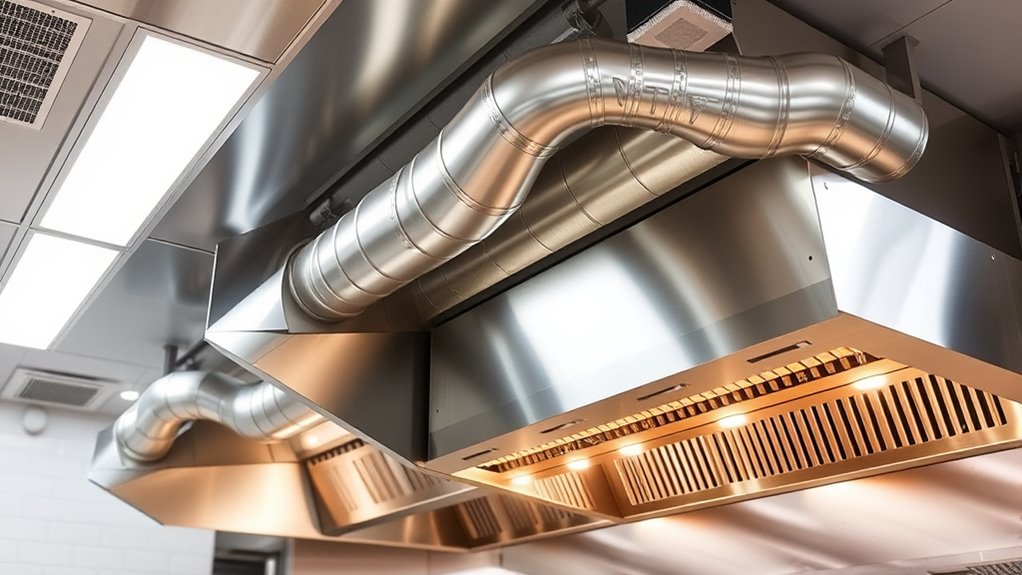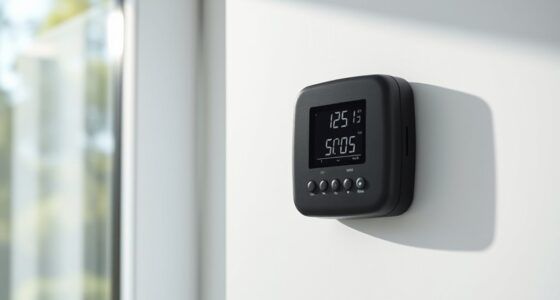To meet ventilation standards for high-heat kitchens, guarantee your system captures heat, smoke, and fumes effectively with properly designed exhaust hoods and fans. You need to use appropriately sized ductwork and filters while providing make-up air to balance airflow. Regular inspection, maintenance, and compliance with local codes like OSHA and NFPA are essential. Incorporating new technologies and staff training can further improve safety and efficiency—discover more details below to optimize your kitchen’s ventilation system.
Key Takeaways
- Ventilation systems must meet local building codes and standards set by agencies like NFPA and OSHA.
- Exhaust hoods should have sufficient capture and exhaust capacity based on appliance heat output.
- Ductwork must be smooth, sealed, and correctly sized to minimize resistance and airflow loss.
- Regular inspection and maintenance of filters, fans, and ductwork are required to ensure compliance and safety.
- Make-up air systems should balance airflow, providing fresh air to maintain proper pressure and air quality.
Understanding the Importance of Proper Ventilation in High-Heat Kitchens
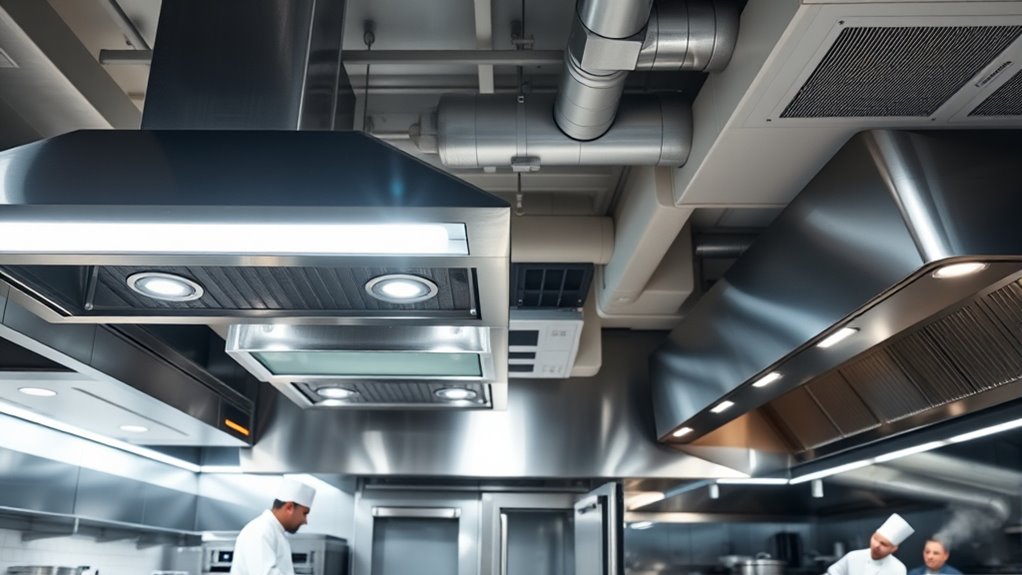
Proper ventilation is essential in high-heat kitchens because it directly impacts air quality and safety. When you’re working in such an environment, heat, smoke, and fumes can quickly build up, making the air unsafe to breathe. Without adequate airflow, you risk heat exhaustion, respiratory issues, and even fire hazards. Proper ventilation helps remove airborne contaminants, keeping the air clean and breathable. It also reduces humidity levels, preventing mold growth and equipment corrosion. Additionally, good airflow can improve comfort, allowing you to work more efficiently and safely. Recognizing the importance of ventilation means understanding how it maintains a healthy, safe kitchen environment, protecting both staff and patrons from the dangers associated with high heat and airborne pollutants. Modern ventilation standards are designed to ensure optimal air exchange and safety in these demanding environments.
Key Components of Effective Kitchen Ventilation Systems
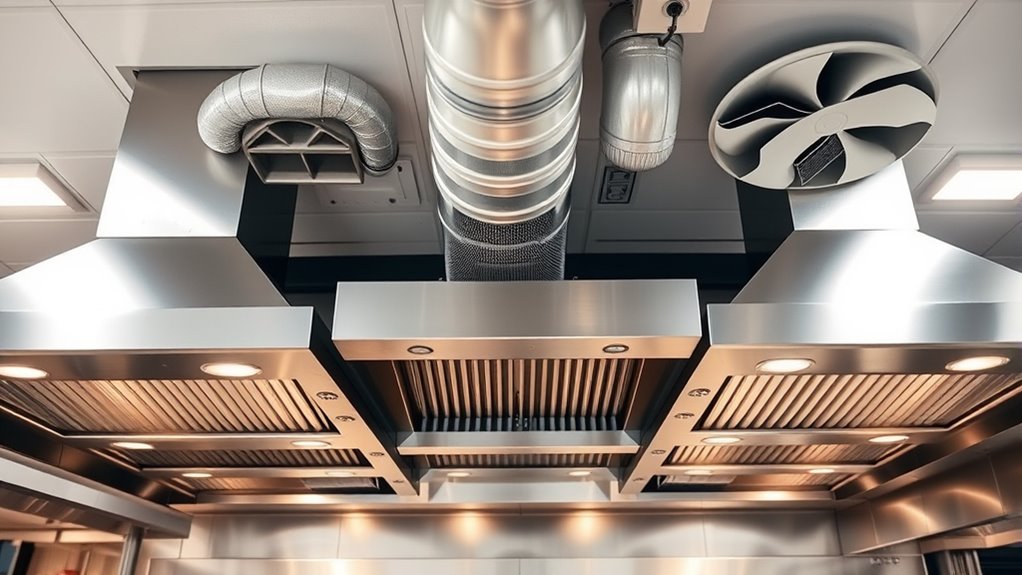
An effective kitchen ventilation system relies on several key components working together to remove heat, smoke, and airborne contaminants efficiently. The exhaust hood is the centerpiece, capturing rising heat, fumes, and grease. It should be properly sized and positioned directly above cooking surfaces to maximize capture efficiency. The exhaust fan pulls contaminated air out of the kitchen, so choosing a fan with adequate capacity is essential to ensure proper airflow. Make-up air systems supply fresh air to replace what’s removed, maintaining balanced pressure and preventing drafts. Ductwork connects these components, so it must be smooth, sealed, and appropriately sized to minimize resistance and noise. Lastly, filters trap grease and particulates, reducing fire risks and maintaining air quality. Proper kitchen ventilation design is crucial for ensuring optimal performance and safety. Together, these components ensure a safe, comfortable, and compliant high-heat kitchen environment.
Regulatory Standards and Compliance Requirements
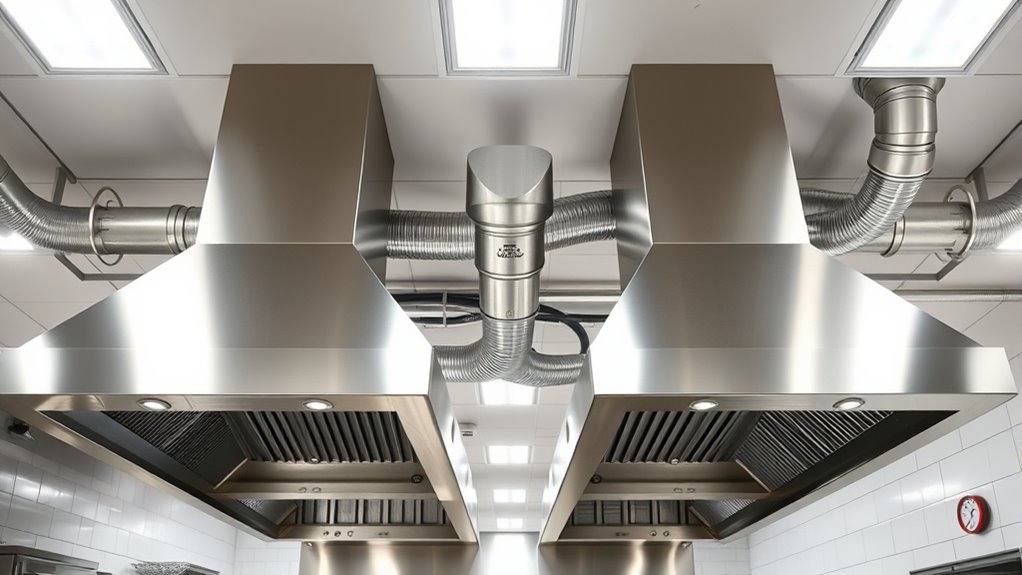
Regulatory standards and compliance requirements set the minimum safety and performance benchmarks that high-heat kitchen ventilation systems must meet. These standards guarantee your ventilation system effectively controls heat, smoke, grease, and odors, protecting staff and customers. Agencies like OSHA, NFPA, and local building codes specify airflow rates, fire suppression measures, and equipment materials. You must regularly inspect, test, and maintain your system to stay compliant and avoid penalties. Documentation of compliance is essential, especially during inspections. Understanding these requirements helps you design and operate a vent system that not only meets legal obligations but also enhances safety and efficiency. Staying current with evolving regulations ensures your kitchen remains compliant and minimizes operational risks.
Designing Ventilation Systems for Different Cooking Appliances
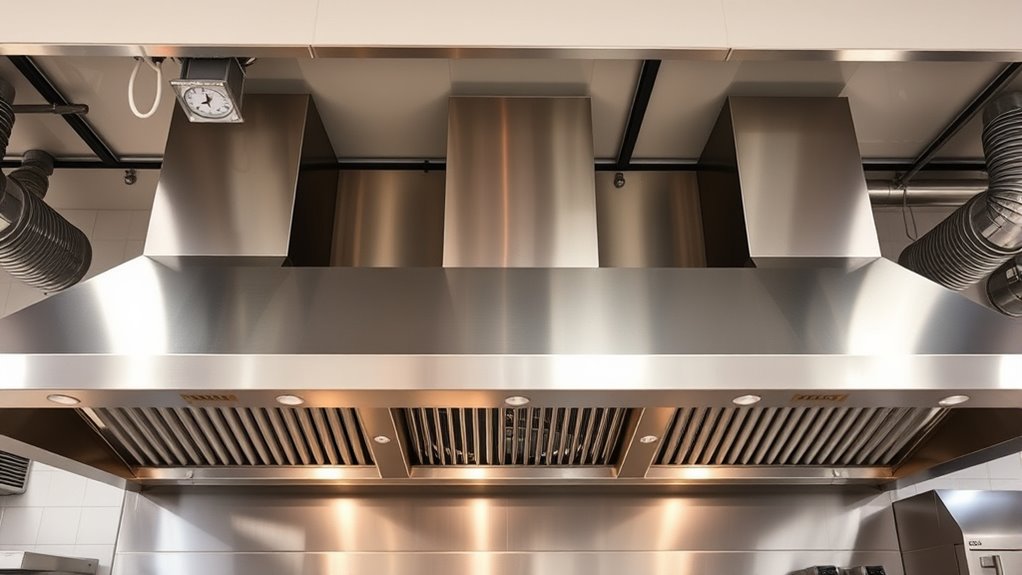
Designing ventilation systems for different cooking appliances requires tailoring airflow and exhaust capabilities to each device’s specific heat output, grease production, and odor emissions. High-heat appliances like deep fryers and griddles generate significant heat and grease, so you need powerful hoods with high capture velocities to effectively remove contaminants. For stovetop burners, adjust airflow to handle moderate heat and grease, ensuring proper removal without excessive energy use. Ovens produce less grease but emit strong odors, so incorporate odor control features like activated carbon filters. You should position exhaust outlets close to heat sources for ideal capture and ensure ductwork is appropriately sized to handle the volume of air moved. By customizing ventilation design, you improve efficiency, safety, and indoor air quality tailored to each appliance’s unique demands.
Maintenance and Inspection Practices to Ensure System Efficiency

To keep your ventilation system running efficiently, you need to regularly check the filters and make certain they aren’t clogged. Establish a consistent inspection schedule for your ductwork to spot leaks or buildup early. Staying on top of these tasks helps maintain ideal airflow and safety in your high-heat kitchen. Consulting best practices for maintenance can further improve system longevity and performance.
Regular Filter Checks
Regularly checking and maintaining filters is essential to keep ventilation systems operating at peak efficiency in high-heat kitchens. Dirty or clogged filters restrict airflow, leading to decreased removal of heat, smoke, and grease. You should inspect filters weekly and replace or clean them as needed, especially during busy periods. Use appropriate tools to remove dust, grease buildup, and debris that can accumulate quickly in a high-heat environment. Well-maintained filters ensure proper airflow, reduce strain on fans, and improve indoor air quality. Keep a log of filter inspections and replacements to track maintenance schedules. Regular filter checks prevent system failures, reduce energy consumption, and extend the lifespan of your ventilation equipment. AI-driven solutions can also assist in monitoring filter conditions remotely and predicting maintenance needs more accurately. Consistent maintenance helps maintain a safe, efficient working environment for kitchen staff.
Ductwork Inspection Schedule
How often should you inspect and maintain your ductwork to guarantee ideal system performance? You should schedule inspections at least twice a year, especially before peak cooking seasons. Regular inspections help identify blockages, grease buildup, or damage that can hinder airflow and reduce efficiency. Look for signs of corrosion, loose connections, or leaks, and clean or repair as needed. Keep ductwork free of debris and grease to prevent fire hazards and maintain proper ventilation. Don’t forget to check insulation and seals—damaged sections can cause heat loss and inefficiency. Establishing a routine inspection schedule ensures your system runs smoothly, prolongs its lifespan, and maintains compliance with safety standards. Consistent maintenance is key to high-heat kitchen ventilation success. Additionally, understanding sound vibrations and their impact on system components can help optimize airflow and reduce noise levels.
Innovations and Technologies Enhancing Ventilation Performance
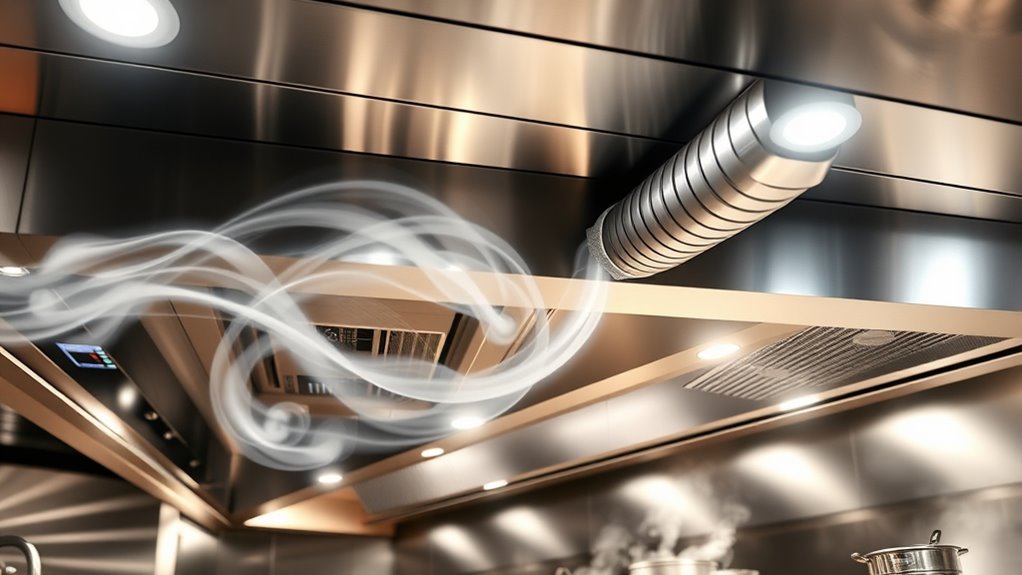
Innovations and technologies are transforming ventilation systems in high-heat kitchens by improving efficiency and safety. Advanced sensors now monitor temperature, humidity, and air quality in real time, allowing automated adjustments to ventilation rates. This guarantees ideal airflow, reducing energy waste and preventing heat buildup. Energy-efficient fans with variable speed controls adapt to kitchen activity, saving power while maintaining air quality. UV-C sterilization units eliminate airborne pathogens, enhancing safety for staff. Smart ductwork design minimizes airflow resistance, boosting system performance. Additionally, remote monitoring platforms enable quick diagnosis and maintenance, reducing downtime. These innovations ensure that ventilation systems operate at peak performance, providing a safer, more comfortable environment while complying with evolving standards. Incorporating AI-driven analytics can further optimize system operation by predicting maintenance needs and adjusting parameters proactively.
Best Practices for Staff Training and Safety Protocols
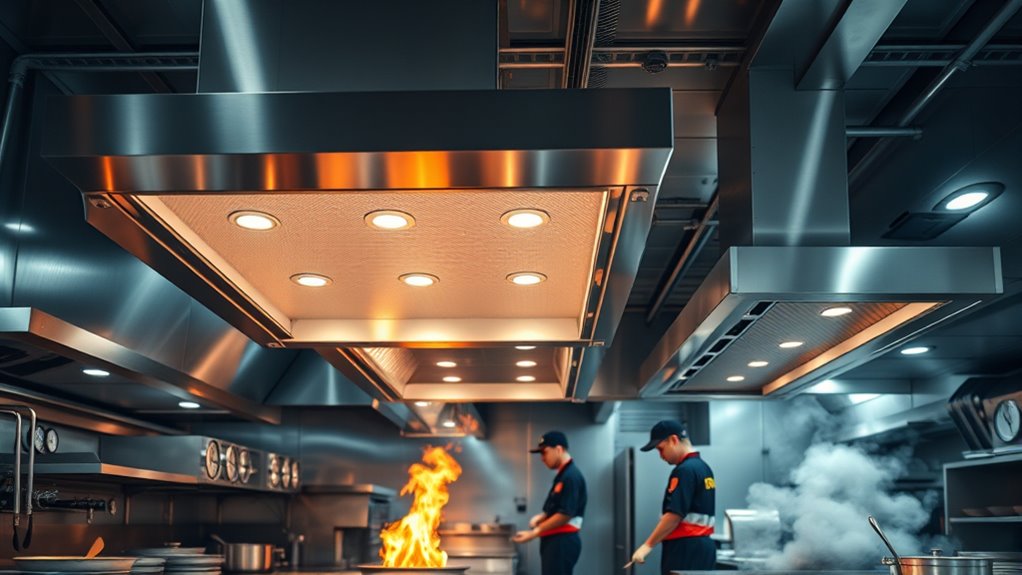
Effective staff training and safety protocols are essential for maintaining a safe and efficient high-heat kitchen environment. You should guarantee all team members understand proper ventilation practices, including how to operate exhaust systems correctly and recognize signs of poor air quality. Regular training sessions keep staff updated on safety procedures, fire prevention, and emergency response. Encourage clear communication and accountability to prevent accidents. Implement routine safety drills to reinforce protocols and identify areas for improvement. Make safety equipment and ventilation controls easily accessible and well-maintained. Promote a culture of safety where staff feel empowered to report hazards without hesitation. Consistent training and strict adherence to safety protocols minimize risks, support compliance with standards, and create a safer, more productive kitchen environment for everyone. Additionally, emphasizing digital literacy helps staff stay informed about new safety technologies and best practices.
Frequently Asked Questions
How Does Ventilation Impact Indoor Air Quality in High-Heat Kitchens?
You might wonder how ventilation affects indoor air quality in high-heat kitchens. Proper ventilation removes heat, smoke, and airborne contaminants, preventing buildup of pollutants that can harm health. It also helps control humidity and odors, making the environment safer and more comfortable. When ventilation works efficiently, it reduces the risk of respiratory issues and improves overall air quality, ensuring a healthier workspace for everyone in the kitchen.
What Are the Energy Efficiency Considerations for Ventilation Systems?
When you consider energy efficiency for ventilation systems, you should focus on selecting models with high efficiency ratings and adjustable settings. You wanna guarantee the system operates only when needed, using sensors or timers to reduce unnecessary energy use. Proper maintenance also matters; clean filters and ducts keep the system running smoothly. By choosing efficient equipment and managing its operation wisely, you can lower energy costs without sacrificing indoor air quality.
How Can Ventilation Systems Be Adapted for Small or Limited Kitchen Spaces?
When adapting ventilation systems for small or limited kitchen spaces, you should prioritize compact designs that maximize airflow without crowding your area. Use wall-mounted or ductless units to save space, and choose models with adjustable speeds for better control. Regularly clean filters and make sure proper placement to optimize efficiency. By focusing on these strategies, you’ll improve air quality and safety without overwhelming your small kitchen.
What Are the Common Causes of Ventilation System Failures?
Imagine a detective solving a mystery — that’s you identifying causes of ventilation failures. Common issues include grease buildup blocking filters, which hampers airflow, or motor failure due to overheating from constant use. Poor maintenance, clogged ducts, or electrical problems also contribute. When these failures occur, expect poor air quality, increased fire risk, and uncomfortable working conditions, much like a ship’s engine failing mid-voyage. Regular checks keep your system running smoothly.
How Does Climate Influence Ventilation Design Choices?
Climate plays a significant role in your ventilation design choices. In hot, humid regions, you need systems that effectively remove moisture and heat, preventing mold and discomfort. Conversely, in colder climates, you should focus on maintaining indoor warmth while controlling humidity. You might also incorporate features like outdoor air intake or heat recovery to enhance efficiency and comfort. Understanding your climate helps you select the right ventilation solutions for ideal indoor air quality.
Conclusion
Think of your kitchen ventilation as the heartbeat that keeps your space alive and safe. When it beats strong and steady, it shields you from danger and fuels your passion for cooking. Neglect it, and chaos can take over like a storm uncontained. By prioritizing proper design, maintenance, and innovation, you guarantee this essential rhythm remains unwavering—protecting your team and your culinary creations. A well-ventilated kitchen is the steady pulse of a thriving kitchen.
